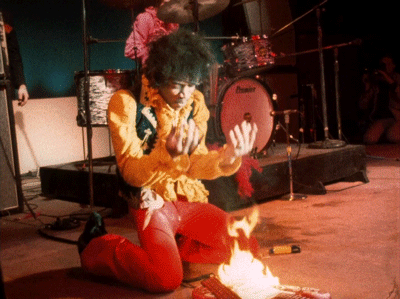“I get a kick out of playing. It’s the best part of this whole thing, and recording too. I wrote a song called ‘I Don’t Live Today,’ and we got the music together in the studio. It’s a freak-out tune. I might as well say that, ’cause everyone else is going to anyway…” – Jimi Hendrix
“Freak out” is an apt way to describe how the world reacted to Jimi Hendrix. In 1966, the rock legend arrived in London an unknown guitarist from New York City looking to establish himself as a star. In September, former Animals bassist-turned-music manager Chas Chandler began taking Hendrix around The Smoke, and actively recruited a band to support him, nabbing drummer Mitch Mitchell and bassist Noel Redding. That same month, at a Cream show at Regent Street Polytechnic, Hendrix took the stage alongside that power trio to play a kinetic version of Howlin’ Wolf’s “Killing Floor.” After a short tour of France, The Jimi Hendrix Experience were signed to Track Records by Chris Stamp and Kit Lambert, managers of The Who.
“Chas asked me to come to England and get a group going together,” Hendrix would tell Jann Wenner in 1968. “Chas knows a lot of telephone numbers. Like Georgie Fame and the Blue Flames and all these other people. We had a jam and Noel came around. Noel plays guitar really. He came for the auditioning of the new Animals and we happened to be in the same building. Chas asked him to play bass and it worked out. Then we start playing almost every day for so long, rehearsed for three days then played the biggest theater in Europe, the Paris Olympia, with Johnny Hallyday…It is the biggest thing in Europe. The reception was great and we played four songs.”
By October 1966, the buzz around The Jimi Hendrix Experience was deafening. They played a legendary set at London’s Bag O’ Nails club, with luminaries like Mick Jagger, Brian Jones, Eric Clapton, John Lennon, Paul McCartney and Jeff Beck in attendance. After that show, the U.K. press began fawning over Jimi Hendrix and his trio. In November 1966, they would record the first Jimi Hendrix Experience single, “Hey Joe” backed with “Stone Free,” a Hendrix original.
“It just happened to come about that we were around at the time of psychedelia and all the in clothes. I dug that scene, but not necessarily what you call the ‘hippie scene,’” Hendrix told Steve Barker in 1967. “‘Cause I don’t like classification anyway, regardless of the scene.”
Are You Experienced would be released on May 12, 1967, to tremendous commercial success, but some prominent reviewers were taken aback by Hendrix’s musical approach. Jon Landau famously derided the album as “…unrelentingly violent, and lyrically, inartistically violent at that.” But it was an epochal recording amongst musicians at the time, and has come to be regarded as one of the greatest debuts in rock history. Definitive songs like “Purple Haze,” “Foxey Lady” and the title track are anthems for their era and benchmarks for what hard rock could achieve creatively and sonically.
Nonetheless, beyond his musical contributions, Hendrix’s free-spirited philosophy and uninhibited performance style earned him a “wild man” reputation that sometimes overshadowed his music, and he often bristled at the way he was presented in the British press.
“I don’t want to be a clown anymore. I don’t want to be a ‘rock and roll star,’” Hendrix would famously tell Rolling Stone in 1969. For many observers, the spectacle of Hendrix overpowered his musicianship— a situation he would come to resent. While praising his musicianship, Eric Clapton was critical of Hendrix’s performance style. “That stuff he does on stage, when he does that he’s testing the audience. He’ll do a lot of things, like fool around with his tongue and play his guitar behind his back and rub it up and down his crotch. And he’ll look at the audience, and if they’re digging it, he won’t like the audience. He’ll keep on doing it, putting them on. Play less music. If they don’t dig it, then he’ll play straight ‘cause he knows he has to. It’s funny.” In that same 1968 interview, Clapton wallowed in the same sort of “black exotic” view of Hendrix that Jimi was growing tired of. “When he first came to England, you know English people have a very big thing towards a spade. They really love that magic thing, the sexual thing. They all fall for that sort of thing. Everybody and his brother in England still sort of think that spades have big dicks. And Jimi came over and exploited that to the limit, the fucking tee. Everybody fell for it.”
But even after the success of Are You Experienced and the British fixation on his “otherworldliness” and race, Hendrix would continue to push sonic and aesthetic boundaries up through his untimely death in 1970. And as he did so, he set the stage for a new kind of black musical star.
Prior to Jimi Hendrix’s emergence, black popular artists were still mostly presented through a veneer of conservatism. The buttoned-down suits of Otis Redding and Marvin Gaye, the glamorous nightgowns of the Supremes, the slick conk of James Brown—there was a sense that black artists had to present themselves in as dapper a fashion as possible to counter any racist perceptions of black people and black performers. Even after the British Invasion led to white artists growing their hair long and as “Flower Power” hippie imagery had begun to take over rock’s popular presentation, black artists hadn’t been afforded that same rebellious exhibition. That all changed with Jimi Hendrix.
After Hendrix’s success, popular black artists began to shake off the more buttoned-down image that had defined ‘60s soul music. As funk began to gain ground and as LSD became more prevalent in the culture, there was an embrace of drug references, “free love” idealism, and anti-war rhetoric—alongside more explicit declarations of blackness from artists such as James Brown. Within months of Are You Experienced, Sly & the Family Stone would release their debut album. A Whole New Thing was one of the first soul/funk releases that was unmistakably psychedelic, and it set the stage for the Family Stone’s greater innovation in funk and psychedelic soul on their subsequent albums. In 1969, The Impressions (The Young Mod’s Forgotten Story), Isaac Hayes (Hot Buttered Soul), and The Temptations (Cloud Nine) would all be recording psychedelic music, and by the time the Jackson 5 debuted at the tail end of that year, with their distinctive afros and psychedelic-influenced bubblegum soul, the image and sound had totally shifted from the “My Girl” days of slick hair and sharp suits.

The impact of Hendrix on black music stretches far beyond the 1960s, of course. George Clinton’s P-Funk collective pushed what had been considered psychedelia to an entirely new plateau in the 1970s, but their embrace of “freaked out” looks, subject matter and sounds wouldn’t have happened without Hendrix kicking the proverbial door down years prior. “We created funk for outer space: myself, Jimi Hendrix, Sun Ra, David Bowie and Labelle,” Clinton would explain in 2016. “All of that was the beginning of the theatrical sci-fi.” P-Funk bassist Bootsy Collins put it more succinctly. “Hendrix was God,” Collins told The Guardian in 2011 after providing voiceover for a documentary about the legendary guitarist. “In fact, he still is.”
The lineage that starts at Hendrix and stretches through Sly and P-Funk in the ‘70s also connects to later performers like Rick James and Prince and bands like Fishbone and Living Colour; and to more contemporary artists like OutKast, D’Angelo, and Meshell Ndegeocello. That spirit of black creativity as filtered through non-conformity and freedom, an expressive cocktail made of ingenuity and sensitivity, a creativity informed by otherness—it’s an integral part of black musical heritage.
Oftentimes when we discuss Hendrix and his legacy, his impact as a guitarist overshadows the more nuanced aspects of his influence. Undoubtedly, Jimi Hendrix unlocked the creative potential of the guitar in a way that cannot be overstated; one would be hard-pressed to find anyone more revolutionary on their respective instrument. But beyond just his uniquely significant impact on how guitar is played and recorded—and even beyond his still undervalued talents as an all-around musician, producer and songwriter—there is his influence on black art, specifically. Resisting the ahistorical urge to always view Jimi as a black anomaly in a white genre, (Love’s Arthur Lee, Richie Havens, and the Chambers Brothers were among his black rock artist contemporaries), it’s important to present Hendrix as a part of the black musical tradition: his showmanship born of T-Bone Walker, his artistry as celebrated by Miles Davis, and his impact that trickles down to Childish Gambino. Jimi Hendrix helped remind the world that black art wasn’t meant to be shackled by the expectations of racism. Or defined by it. He let his freak flag fly. And we’re all better off for it.






